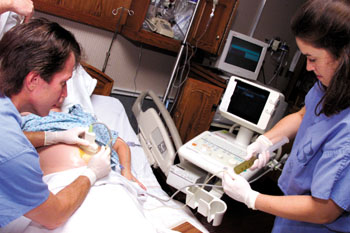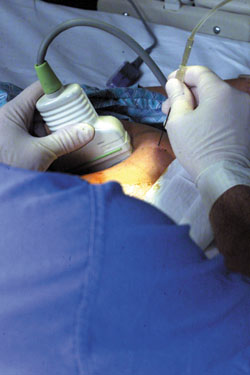
Dr. Joseph Bruner and Dr. Erin Harley perform the amniotic exchange to combat gastroschisis. (photo by Mary Donaldson)
Fetal study first in U.S.

In the procedure a flexible needle is inserted into the mother’s womb and guided by ultrasound to draw out all the amniotic fluid and replace it with sterile saline solution. (photo by Mary Donaldson)
At 1:30 p.m. on Friday, July 7, a middle Tennessee woman lay in Labor and Delivery room 10, her belly slightly swelled with her first expected child. Her husband gently stroked her head as her doctor passed an ultrasound wand over her womb. He was preparing to begin a new research procedure that, hopefully, would improve the fetus’ health even before birth.
With another 12 weeks to term, the couple’s baby was about to receive a first bath, of sorts. The fetus had been diagnosed with gastroschisis, a developmental abnormality that caused the intestines to poke through a weakness in the abdominal wall and into the mother’s uterus, where the amniotic fluid was becoming increasingly concentrated with urine and toxic to the delicate internal organs turned outward.
To halt the damage, Dr. Joseph P. Bruner, associate professor of Obstetrics and Gynecology and director of Fetal Diagnosis and Therapy, inserted a flexible needle into the mother’s womb, guiding it by ultrasound, while Dr. Erin Harley, a resident, drew out all the amniotic fluid with a large syringe and replaced it with sterile saline solution.
Not only was this a first for the fetus, the “amniotic exchange” was the first performed in the United States for gastroschisis, and one of a handful performed in the world. In June, Bruner began a randomized study of the procedure. Two other couples have been randomized into standard therapy – delivering the babies early and surgically mending the damaged intestines when time allowed.
“We’re just glad to be a part of this,” said the young dad, naturally a little anxious. “We hope that, regardless of our outcome, this improves the treatment for everyone.” The couple’s names cannot be released in order to preserve their identity. For the study, pediatric surgeon Dr. Robert Cywes, assistant professor of Surgery, will follow the enrollees and will not know who received amniotic exchange or standard therapy.
Bruner called the procedure, which includes a total of four amniotic exchanges over eight weeks, “deceptively simple.” It can be performed in less than an hour, in most labor-and-delivery settings.
“This is a whole new area never addressed before – altering the amniotic constitution to protect vulnerable fetal body parts from amniotic fluid to treat fetal disorders,” he said.
Gastroschisis is not a life-threatening disorder, Bruner said. But it occurs in one in 4,000 live births in the United States. Fourteen children born at Vanderbilt in 2000 had the disorder.
Previous Vanderbilt research has shown that at about 30 weeks gestation the amniotic fluid becomes increasingly toxic and harmful to body parts not meant to be exposed to it. With gastroschisis, the intestines “become inflamed, almost as if they had been burned,” Cywes said. They shorten, sometimes by as much as one-third, and can form atresias, leaving gaps in the bowels.
After birth, the exposed bowel requires a “tent” to protect it while it heals enough to allow surgery. These babies often have delays in their first full feedings, longer times in a neonatal intensive care unit, longer waits to surgical intervention and longer hospital stays.
In Paris, France, where the procedure was developed, researchers believe simply exchanging the toxic fluid for sterile liquid prevents damage. At Maternity de l’Hopital Robert-Debre, 20 patients received the amniotic exchange with 30 to 50 percent improvements to all the complications, and none of the infants required tube feeding, said Bruner, who learned of the technique from its first investigator during a conference last year.
There are two points of debate: that with standard therapy early delivery of the fetus will prevent injury to the bowel, and that cesarean sections help protect the bowel. The study, Bruner said, will address these concerns by seeing the babies to term and delivering them vaginally, when possible.
There is a risk of premature delivery. But, Bruner said, the risk also exists with the disorder, regardless of intervention.
“There’s no doubt in my mind that once we publish the results of this study the management of gastroschisis will change overnight,” Bruner said. He hopes to enroll 20 patients this year, and expects as many as a dozen other U.S. medical centers and several more across the globe to join the study. The study is currently funded by a VUMC Discovery Grant; NIH funding is speculated for the future.
Cywes agrees that the procedure soon will be widely accepted, and said that it’s important for it to begin with data from a randomized, controlled study. “People are going to be doing this. We want to make sure they’re doing it for the right reason,” he said.
Patients enrolled in the study receive a series of counseling sessions to explain fetal medicine, including talks with social workers, ethicists, financial coordinators and the surgeons. The babies will be followed after birth through the NICU and corrective surgery. There will still be questions to answer in subsequent research, Bruner said, including patient selection and how many exchanges are optimal.
After about 40 minutes, Bruner and Harley had drawn out 280 ccs of fluid, replaced it with 300 of saline, then removed another 300 and finally bathed the fetus in an equal amount of sterile solution. After the first drought the fluid was a dense, dull yellow; after the second it was almost clear. Samples were collected for analysis here and in Paris to determine what irritates the bowel.
With the procedure finished, both expectant parents smiled and breathed easier, glad there was an option that might help their baby, and possibly many others.













